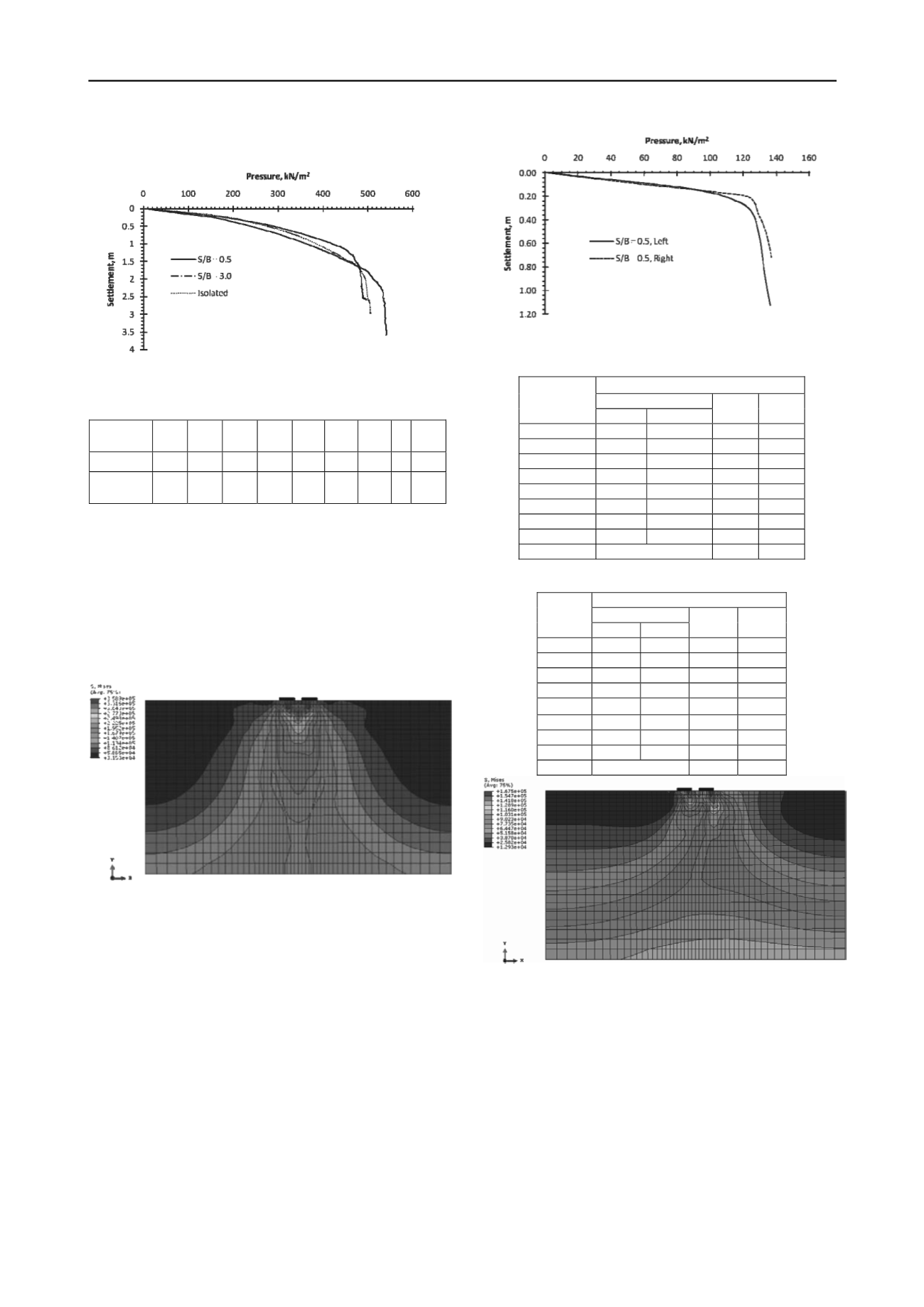
3461
Technical Committee CFMS /
Comité technique CFMS
100 kPa assuming it to be in the range of working load. The
same are presented in Table 2.
Figure 5. Pressure settlement curves for case a
Table 2. Bearing capacity and settlements of footing for case a.
S/B
0.5
1
1.5
2
2.5
3
3.5 5 Isolat
ed
UBC, kPa
545 520 515 510 505 495 495 495 495
δ, mm (at
100 kPa)
156.5 148.1 141.3 135.9 131.4 127.8 124.7 118 105.7
It is observed from Table 2, that the UBC of interfering
footings decreases with increase in S/B ratio and attains the
value as that of isolated footing at higher spacing. At S/B = 0.5,
the UBC is observed to be increased by about 10% compared to
isolated footing. This is due the overlapping of the stress zones
of individual footing when placed close to each other. The same
can be observed from the stress contour plot as presented in
Figure 6. Similar kind of variation is seen for the settlements at
working load. The settlement is increased by 48% when the
footings are placed at S/B = 0.5 and the percentage increase in
the settlement decreases with increase in S/B ratio.
Figure 6. Stress contour for case a at S/B equal to 0.5.
As the case b, is unsymmetrical case the pressure settlement
curves are obtained for both left and right footings at different
S/B ratio and are seen to be non-identical. The pressure
settlement curve for case b is obtained at S/B = 0.5 and shown
in Figure 7. The UBC is calculated owing to the interference for
left and right footings placed at different spacing and are
presented in Table 3. Similarly the settlements, δ obtained at
working load of 100 kPa are presented in Table 4. It is observed
that the UBC of both footings decreases by 14% at S/B = 0.5
compared to that of isolated footing under same loading
condition. However, at S/B = 2.5, the UBC of two footings
attain a value as that of isolated footing and remains constant
with further increase in S/B ratio. It is also observed that the
settlement of left and right footing at working load is increased
by 59% and 49% at S/B = 0.5 and decreases to 23% and 11%,
respectively at S/B = 5.0 compared to that of isolated footing.
The stress contour for case b at S/B = 0.5 is shown in Figure 8
and it is seen that the stress contours of right footing do not
overlap much with that of left footing and hence negligible
interference phenomenon is observed however the effect on
settlement is higher.
Figure 7. Pressure settlement curve of case b at S/B = 0.5.
Table 3. UBC (kPa) of interfering footings for case b, c and d.
Case
b
S/B
Left
Right
c
d
0.5
125
125
135
140
1.0
128
130
145
145
1.5
130
130
145
145
2.0
140
140
145
145
2.5
145
145
145
145
3.0
145
145
145
145
3.5
145
145
145
145
5.0
145
145
145
145
Isolated
145
145
145
Table 4. Settlement, δ (mm) obtained at 100 kPa load.
Case
b
S/B
Left
Right
c
d
0.5
166.79 155.52 155.96 155.04
1.0
162.61 145.84 148.28 146.46
1.5
157.10 140.21 141.69 140.95
2.0
151.56 135.44 131.91 136.38
2.5
146.94 130.85 130.95 132.52
3.0
142.59 126.93 127.16 129.11
3.5
138.66 123.57 124.04 126.10
5.0
128.95 116.13 117.03 118.97
Isolated
104.70
104.70 104.70
Figure 8. Stress contours for case b at S/B equal to 0.5.
Similarly, the pressure settlement curves are obtained for
case c and case d. It is observed that the curves obtained from
both left and right footings are exactly identical. From the
obtained curves, the UBCand settlements at working load of
100 kPa are obtained and the same are tabulated in Table 3 and
Table 4, respectively. The pressure settlement curves obtained
for footings placed at S/B = 0.5 are shown in Figure 9 for case c
and case d. The stress contour plot for case c and case d
obtained by placing the footings at S/B = 0.5 are shown in
Figure 10 and Figure 11 respectively. It is observed that the
UBC of interfering footing decreases by 7% at S/B = 0.5 and at
all S/B ratios the bearing capacity value remains same as that of
isolated footing, revealing negligible or no effect of interference
on the bearing capacity. However significant effect of
interference on the settlement is observed. 49% increase in


